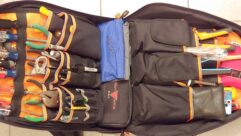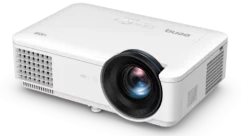Video review:Running wire
Mar 1, 1996 12:00 PM,
By William D. Costigan
Wire Running, As Easy As That, produced and written by Roy Bowling, Complete Vision Productions, 7 VHS tapes, 2 hr, 33 min, 1995, $495.Fellow installer, technician, ye tireless runner of the stranded wire, it’s time to set down that rusty old fish tape for a moment and read about Roy Bowling, a man with a mission. His mission, should you choose to lay down your credit card, is to teach you how to make more money by doing less. Bowling stars in seven live-action videotapes, as do his nifty gadgets.
Bowling is a well-known teacher of the art of running wires. He speaks the language of the installer, having run his own alarm company for 15 years and having taught more than 10,000 installers how to conceal wires in existing construction. He’s a downright character. If you’ve ever been to a National Systems Contractor Association Expo or a Custom Electronic Design and Installation Association Expo or an International Security Conference meeting, you’ve likely seen him demonstrate his sharp skills and sharper wit in seminars about wire running.
While watching and listening to Bowling in action, whether live or on VHS tape, you know he’s paid his dues in the business and in the field. In addition to teaching, he’s the founder of Labor Saving Devices, a company specializing in tools specifically for the wire installer.
The price of his seven-tape set is $495. I’d been wanting a faster modem and a tape backup system for my outdated computer, so I was skeptical about the price tag as I sat down to watch the tapes. I found the tapes filled with potentially useful time-saving, money-making information. You may find Bowling’s tapes are the way to go for tips and techniques that will quickly earn back the money, plus a lot more.These tapes discuss many alternate techniques for running wire, but only in typical stick-frame construction: 2×4’s, wood studs and drywall. I can’t see how most of them could be applied to commercial construction or so-called fireproof construction, steel I-beams and metal decks or reinforced concrete or concrete block. Also, he’s running AWG#22 twisted pair. Those of us grunting a little harder to pull premium loudspeaker wire or coaxial cable won’t be able to do everything just the same way. An amazing amount of this information does apply, if you apply a little practical common sense.
The first tape, “Dimes and Dollars,” runs 35 minutes and is targeted at the company owner; the rest of the series is for the technicians in the field. Bowling initially reminds us that time is money. With white board and marker, he dives into a maze of figures, discussing the importance of profit margins, productive hours and the value of time. Some of this seemed awkward to me, especially the argument that prewire jobs are both profitless and pointless.
He makes valid points, however, to support his claim that prewiring is inefficient. In the best-case scenario, depending on the size of the job, your crew makes three or four trips to the site just to complete the prewire, and even then you’re only half finished. Bowling thinks you should complete the job in only one or two visits, doing it his way.
He suggests you wait until all of the other trades are done and the house is finished – included carpeted and painted – before you run the wire. This will make eminently good sense after you’ve seen the remaining tapes, in which you see him run wire up, down and all around. He drills a hole and has the end of the wire poking out in seconds. In the end, however, with certain types of construction using certain types of cable, prewiring cannot be avoided. Bowling wins his point anyway: Prewire where you must; avoid it where you can.
The second tape devotes 30 minutes to insulated walls. Here, Bowling attacks the ever-delightful task of running wires in closed walls. He then tames fiberglass-lined bays, with and without a vapor barrier (visquine). Next, it’s blown-in cellulose, a snap when you know how to pull wire through without pulling out a ton of the messy stuff. Finally, closed-cell styrofoam, under his deft hands, melts like butter.Bowling and his production crew went to great effort and detail in building the sets used in these videos. Each tape features a unique set with a cutaway view of the construction, built as you find it on the job. He’s merrily drilling holes through walls, fire stops, ceilings, floors, window casements, crawl spaces and attics. He demonstrates getting it right the first time.
The third tape, “Drill Bits and Fire Blocks,” spends 17 minutes discussing the types of drill bits used by the professional installer and why and which to select for different tasks. Bowling stresses the importance of looking for reference locations the carpenter has left for you, and I agree. If you’re working on a wall with plumbing inside it, you don’t want to reference the water dripping into your drill motor. Most of these tools can be purchased from a large industrial hardware supply house or from a good alarm supply company. You may also choose to buy the needed tools through Labor Saving Devices, Bowling’s tool company.
“Unique Bits and Baseboards,” the fourth tape, shows in 18 minutes how to run wire along the carpet tack strip. You’ll learn the proper way to remove baseboards without danger of denting the drywall and what to do when they’re off. Bowling then pulls out another of his incredible gadgets. This one lets you push the drill down but make a hole going up, from floor level through the drywall, the base stud, or shoe plate, and into the wall cavity. He then demonstrates how to pull the wire from the floor up into the wall cavity. Good stuff! More unique drill bits are shown in this tape.
The fifth tape, “Fishing Between Floors,” is 16 minutes long and demonstrates how to get the wire from the wall cavity into the ceiling cavity and then across the ceiling. If you’ve ever spent a hour trying, you’ll appreciate his demonstrating it in minutes. He uses the impressive “wet noodle,” a ball-chain that a magnet can grab, and the “wall eye,” a mini-periscope with a built-in flashlight. Running wires between floors now becomes a game rather than an agony.
The sixth tape, “Finished Basements and Crawl Spaces,” is 19 minutes long. It’s an excellent tape for anyone who doesn’t enjoy an aching back and varmint bites. Throughout these tapes Bowling stresses the importance of cleaning as you progress, not waiting until the end of the installation. The Dirt Devil keeps coming out every time drilling leaves a pile of shavings. This is a point well-taken if you care about referrals to future customers.
The worst of all procedures faced by the wire puller, the one that turns him into a victim, is “Attic Fishing,” covered in 18 minutes in tape seven. If the attic is tight, if you’re swimming in itchy fiberglass, if your head doesn’t like to be cracked by rafters, if rafters have nail points poking through at just the right place, and if we’re experiencing a record heat wave, then the attic is hell on earth. I found this tape the most enlightening, with great information and tools. Bowling shows how to get the wire from the wall cavity into the attic and then retrieve the wire from the middle of the attic with an extending rod. This beats the alternative, lying face down in the fiberglass, hoping to stay on the joists and not fall through. That’s the worst!
On a technical production note, I was a little let down by the quality of the camera and camera work and especially the audio quality. A good wireless microphone would have made it sound much more professional.
Bowling’s information is quite useful. But its usefulness will vary according to the existing skill level of the installers and the types of projects your company performs. If your primary focus is commercial construction, and you work only with metal studs and beams, many of these techniques won’t apply to your work. On the other hand, if you only occasionally work in wood-frame construction, maybe those parts will be most valuable to you because you will never have sharpened those skills from experience.Although these tapes include explicit mentions of only alarm installation, with a little common sense fellow residential audio-visual installers and technicians will definitely benefit from Bowling’s knowledge and techniques. And don’t forget this: After running wires for almost 15 years, I’ve found it’s one thing to be good at it and quite another to have the patience, disposition and time needed to train someone else properly. This brings us back to where the tapes began: Time is money.For information about ordering these videotapes, circle (261) on Rapid Facts Card.










